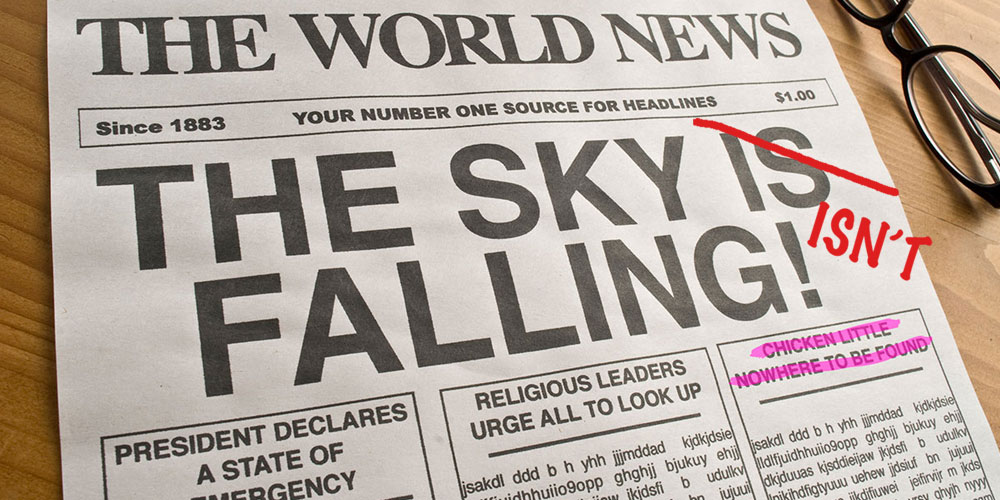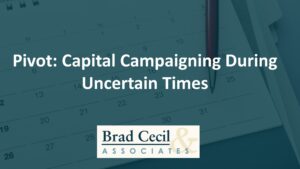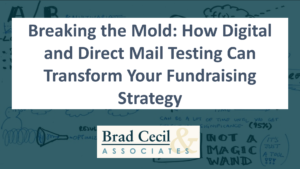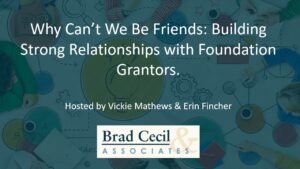The new Fundraising Effectiveness Project report is out and the news isn’t good:
-
Donor count is down -5.8% from the same time last year
-
Donated revenue is down -7.3% from the same time last year
-
Donor retention is down -0.9% from the same time last year
-
Revenue by donor level:
-
General Donor revenue down -0.2%
-
Mid-level Donor revenue down -3.5%
-
Major Donor revenue down -8.2%
-
The early reports on giving in the first half of the year are concerning and fundraisers are anxious heading into the year-end giving season. Many non-profit staff, fundraisers, consultants and agencies are so concerned that they’re trying to “move the goal post” before the end of the year. In addition to these worrying trends, 2020 will be a significant election year and many fundraisers know how difficult it is to be heard above the noise of an election year.
What can you do to prepare? Follow these three M’s…
1.) Multi-Channel
Fundraising communication must use every channel available if it hopes to reach its audience in today’s market. A multi-channel approach looks like this:
Donors are very likely to receive a direct mail letter and be inspired to act, but first they’ll Google the organization on their phones and click the link at the top of the page. Then they’ll briefly visit the organization’s website, and after a few minutes, log off and talk to their spouses about the organization and the work that they do. Next they’ll receive search ads when web browsing and social media ads when they check their feeds – these will serve as reminders and reinforce their desire to act. In a few days, they’ll get an e-mail reminder.
At some point in the near future, the donors will sit down at their computers to give. They’ll go back to Google and start typing in the organization’s name, click the link at the top of the list, go back to the organization’s website, see the lightbox and click the lightbox link – all before actually making a gift. When they hit the right landing page that has the same artwork, message and offer they were first inspired by, they’ll make their gifts.
You have to use every tool in the box to be seen and heard in today’s fundraising mix:
-
Direct mail
-
Google Analytics
-
Search ads
-
IP matched display ads
-
Email follow-up
-
Social media ads
-
Light boxes
-
Dedicated Landing pages
-
Email gift acknowledgement
This is the new norm – the more impressions the better. Nonprofit organizations must optimize all of these tools to make them work together. Now is the time to prepare. A multi-channel approach is the first step in a successful year-end campaign.
2.) Mid-level Giving
Mid-level donors are generally those that self-identify and give generously. The way most mid-level donors usually appear is in response to a general solicitation with a generous gift. We recommend a revised strategy for mid-level donors using all of the multi-channel tools mentioned above and special consideration taken in the type of communication they receive. One of the problems of standard direct mail and email solicitation is that it doesn’t work well with a significant ask amount. If you are going to ask for a $1,000 gift or more, we recommend a unique proposal-type package with special personalization that looks more formal than a standard direct mail letter. A well-designed strategy will work to motivate mid-level donors and make a significant impact on your year-end revenue.
3.) Major Gifts
Nothing will help you close out 2019 and reach your organizational goals like a strong major donor program. General donors give from discretionary income, major donors give from accumulated assets. The process of developing a major gift is very different than a discretionary gift. You must follow the right steps to realize a major gift and contribute to a life-long relationship with the donor
These four steps are essential:
-
-
Research
Take the time to find out what your donor has supported in the past. The best way to determine a suggested ask amount is past history. Study the donor’s giving pattern and maximum gifts to determine what is important to them. Study their participation with your organization and notice what motivated them and how their giving progressed. Find out who they know and how they’re connected to your organization. Research is easier than ever but is filled with pitfalls if you don’t know what to look for. -
Discovery
Discovery, in my opinion, is the most important part of major donor work. What I mean by discovery is meeting with the donor to uncover their philanthropic interest and motivations. I usually ask the simple question “What are your current philanthropic interests?” and LISTEN carefully to the answer. If a donor gives from their donor advised fund (DAF), find out why they have a DAF. If a donor hasn’t given in a while find out why. Do your homework and do your discovery! -
Ask
Asking is not as hard as most people think. If you do a good job with research and discovery – you’ll know in advance the outcome and the ask will be very natural. But keep in mind you still need to ask – If you don’t ask you won’t receive. -
Stewardship
If discovery is the most important step, then stewardship is the second most important. Often, fundraisers are so driven by meeting aggressive goals that when a donor says ‘yes’ and an LOI is signed, they send a gift acknowledgment letter and that’s the end of the story. Stewardship is engaging the donor with the gift they’ve given, the outcomes realized and keeping your commitment to the donor (if you told a donor you would send a regular update – keep your word). As a donor myself, I can’t tell you how many times this has happened and how disappointed I was. Stewardship isn’t hard but it does take thoughtful work and clear data instruction. Be a good steward!
-
Follow the three M’s – multi-channel, mid-level and major donor work and the end of 2019 won’t be as bad as you might fear. If you do it right, you just might enter 2020 with a head start.
The sky is not falling if you know the reality and you’re prepared to face it. If you need help, lets us know. Brad Cecil & Associates has experts in all of these areas – direct response, digital, mid-level and major donor fundraising and we would be happy to help you end the year strong.





